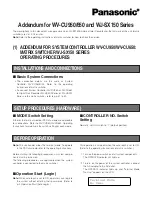
– 699 –
28
F
LOW
S
AMPLING
C
OMMANDS
Flow sampling (sFlow) can be used with a remote sFlow Collector to
provide an accurate, detailed and real-time overview of the types and
levels of traffic present on the network. The sFlow Agent samples 1 out of
n
packets from all data traversing the switch, re-encapsulates the samples as
sFlow datagrams and transmits them to the sFlow Collector. This sampling
occurs at the internal hardware level where all traffic is seen, whereas
traditional probes only have a partial view of traffic as it is sampled at the
monitored interface. Moreover, the processor and memory load imposed by
the sFlow agent is minimal since local analysis does not take place.
Table 56: sFlow Commands
Command
Function
Mode
sflow destination
Configures the IP address and UDP port used by the
IC
Collector
sflow max-datagram-size
Configures the maximum size of the sFlow datagram IC
payload
sflow max-header-size
Configures the maximum size of the sFlow datagram IC
header
sflow owner
Configures the name of the receiver
IC
sflow sample
Configures the packet sampling rate
IC
sflow source
Enables sFlow on the source ports to be monitored
IC
sflow timeout
Configures the length of time samples are sent to the IC
Collector before resetting all sFlow port parameters
show sflow
Shows the global and interface settings for the sFlow PE
process
sflow destination
This command configures the IP address and UDP port used by the
Collector. Use the
no
form to restore the default settings.
S
YNTAX
sflow destination
{
ipv4
ipv4-address
|
ipv6
ipv6-address
}
[
destination-udp-port
]
no sflow destination
ipv4-address
- IPv4 address of the sFlow Collector. Valid IPv4
addresses consist of four decimal numbers, 0 to 255, separated by
periods.
ipv6-address
- IPv6 address of the sFlow Collector. A full IPv6
address including the network prefix and host address bits. An IPv6
address consists of 8 colon-separated 16-bit hexadecimal values.
Summary of Contents for LGB6026A
Page 6: ...ABOUT THIS GUIDE 4...
Page 40: ...38 CONTENTS...
Page 60: ...58 SECTION I Getting Started...
Page 86: ...84 SECTION II Web Configuration Unicast Routing on page 517 Multicast Routing on page 575...
Page 162: ...160 CHAPTER 5 Interface Configuration VLAN Trunking...
Page 196: ...194 CHAPTER 6 VLAN Configuration Configuring MAC based VLANs...
Page 204: ...CHAPTER 7 Address Table Settings Clearing the Dynamic Address Table 202...
Page 238: ...CHAPTER 11 Class of Service Layer 2 Queue Settings 236...
Page 254: ...252 CHAPTER 12 Quality of Service Attaching a Policy Map to a Port...
Page 448: ...446 CHAPTER 16 Multicast Filtering Multicast VLAN Registration...
Page 470: ...468 CHAPTER 17 IP Configuration Setting the Switch s IP Address IP Version 6...
Page 576: ...574 CHAPTER 21 Unicast Routing Configuring the Open Shortest Path First Protocol Version 2...
Page 606: ...604 CHAPTER 22 Multicast Routing Configuring PIMv6 for IPv6...
Page 620: ...618 CHAPTER 23 Using the Command Line Interface CLI Command Groups...
Page 672: ...670 CHAPTER 25 System Management Commands Time Range...
Page 692: ...690 CHAPTER 26 SNMP Commands...
Page 700: ...698 CHAPTER 27 Remote Monitoring Commands...
Page 854: ...CHAPTER 34 Port Mirroring Commands Local Port Mirroring Commands 852...
Page 862: ...860 CHAPTER 36 Address Table Commands...
Page 958: ...956 CHAPTER 40 Quality of Service Commands...
Page 1034: ...1032 CHAPTER 42 LLDP Commands...
Page 1044: ...1042 CHAPTER 43 Domain Name Service Commands...
Page 1062: ...1060 CHAPTER 44 DHCP Commands DHCP Server...
Page 1206: ...CHAPTER 47 IP Routing Commands Open Shortest Path First OSPFv3 1204...
Page 1250: ...1248 SECTION IV Appendices...
Page 1256: ...1254 APPENDIX A Software Specifications Management Information Bases...
Page 1278: ...1276 COMMAND LIST...
















































